Chariots of the Gods?
Among the various conspiracy theories of the 1960s, one of the most popular – and most fanciful – was a book, and later a movie, titled “Chariots of the Gods” by Erich Von Daniken, which made pseudo-scientific claims about extraterrestrial influences on early human cultures. One of the most intriguing segments involved the so-called “Nazca Lines,” a collection of hundreds of enormous geoglyphs in the high desert of Peru, representing birds, animals, insects, mythical figures, trees and flowers.
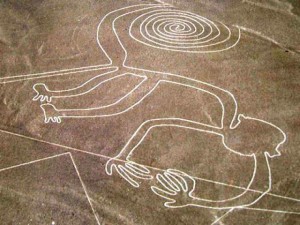
According to Von Daniken, the designs can only be seen from the air, but in reality, they are visible from the surrounding foothills. Although they don’t agree with Von Daniken’s claims that the Nazca Lines were designed as airstrips or landing instructions for visitors from other worlds, most scientists do agree that they had a great deal of cosmological and religious significance for the people who created them. The Nazca Lines have been studied by many American and international scientists from a variety of disciplines, and have been recognized as a UNESCO World Heritage Site since 1994.
California’s “Nazca Lines” Revealed!
Until a few months ago, Chelle and I thought the Nazca Lines were unique, and since they are in a remote area of Peru, we assumed we would never see anything like them. Imagine our surprise when we “discovered” that right here, in an area stretching from southern Nevada to the Gulf of California, running along both sides of the Colorado River in the California and Arizona deserts, there lies a huge area covered with enormous geoglyphs!
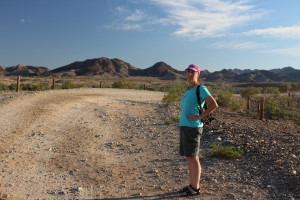
Like the Nazca Lines, they were created by removing a layer of dark pebbles to reveal a lighter surface below, and they appear to have taken significant planning and effort. Also like the Nazca Lines, it is difficult to determine their age or their purpose, but most evidence suggests they held at least religious, if not cosmological significance, for their creators.
Unlike the Nazca Lines, however, these American geoglyphs have received little attention or study from the scientific community, and even less from the general public. They don’t even have a single designation, going by various local names.
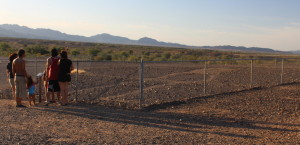
Many are in remote areas, but we found one of the most impressive groups of giant desert figures, known as “The Blythe Intaglios,” was right in the path of our 14th cross-country trip – we were hooked!
The Intaglios: Where? How? What?
Where?
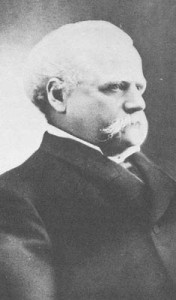
Blythe is a town on the eastern border of Southern California, along the Colorado River, across from Arizona. Named after Henry Blythe, an Englishman who staked a claim to the water from the Colorado River in 1875 in hopes of establishing an agrarian “empire,” Blythe is now best known as a stopover for travelers and campers between Los Angeles and Phoenix. We made our first stop of this trip at Mayflower County Park, right on the Colorado River, unhitched our little red car in 101 degree heat (!), and headed 17 miles north along US 95 to find the mysterious Blythe Intaglios.
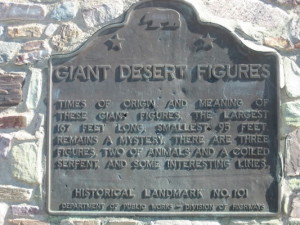
We had learned that California Historical Marker 101 had been placed along the highway many years ago, but it could be easy to miss, so we made sure we got directions to the exact spot from Google maps before we left. When we arrived, we found the Historical Marker was missing!
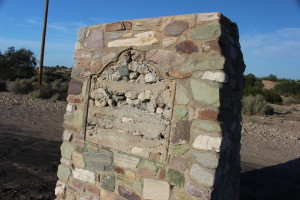
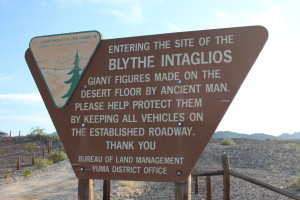
Is this part of the plan for protecting the geoglyphs? The Bureau of Land Management, which oversees the site all the way from Yuma Arizona, doesn’t say. Their website doesn’t offer much information either, and as it says, there are “no amenities” onsite, aside from the hurricane fences that have been placed around each of the intaglios for protection. BLM did place a few signs at the entrance to the site, and descriptions at each of the fenced areas, so you can learn a little about what they might represent while you’re there. There’s not much background about the intaglios onsite, however, so we did some research to help fill in the back story behind these unusual works of art… just for you!

How?

“Intaglio” is a family of printing, printmaking, and artwork techniques in which the image is cut or carved into a flat surface, and the incised or sunken area holds the ink. It’s the opposite of a relief print. Petroglyphs were created using similar techniques, removing the thin dark layer of “desert varnish” often found covering rocks in arid climates. The Blythe Intaglios are in an area where the ground is covered with desert-varnished pebbles over a lighter surface. By removing the darker “varnished” pebbles in carefully planned patterns to expose the lighter surface below, these artists created delicate, enormous images, seemingly aimed toward viewers in the sky. The removed pebbles were then heaped along the edges to further accentuate the glyphs.
What?
The largest image we saw represents a human figure over 100 feet tall, with outstretched arms spanning nearly 65 feet! Although he is primarily a “stick figure,” he possesses what appears to be a phallus, making him at least somewhat anatomically correct, and definitely male.  Nearby, but facing in a different direction, a huge four-legged animal appears to stand close to what may be a coiled snake, presumably keeping a safe distance. What kind of four-legged animal is it? Circles at the end of each leg could be hooves, leading to speculation that the animal is a horse… but horses disappeared from North America at least 10,000 years before they were reintroduced here by the Spaniards in the 16th century, and these figures are thought to be hundreds of years older than that.
Nearby, but facing in a different direction, a huge four-legged animal appears to stand close to what may be a coiled snake, presumably keeping a safe distance. What kind of four-legged animal is it? Circles at the end of each leg could be hooves, leading to speculation that the animal is a horse… but horses disappeared from North America at least 10,000 years before they were reintroduced here by the Spaniards in the 16th century, and these figures are thought to be hundreds of years older than that.
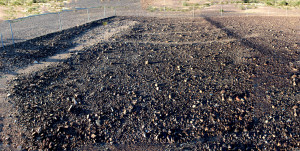
This has given rise to the theory that some horses may have survived the mass extinction, or possibly had been brought to the southwest before Columbus arrived. One theory goes so far as to claim this as “definitive proof” that the Vikings must have delivered the ancestors of the mysterious “horse” depicted in this intaglio!
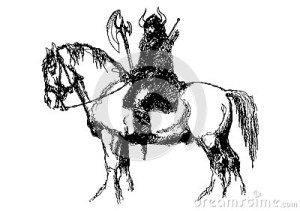
No explanation is offered for what the Vikings were doing in the southwestern desert however, or how they got here. So perhaps this really isn’t a horse after all… what do you think?
Intaglios: When? Who? Why?
When were they discovered”?
 Aside from the indigenous people who created them, the Blythe Intaglios were first noticed by an Army Air Corps pilot named George Palmer who was flying over the desert between the Maria Mountains and the Colorado River in November 1931. Palmer described giant human and animal shapes: “Near two of the human shapes are figures of serpents and four-legged animals with long tails. One giant, or god, appears just to have stepped out of a large dance ring.” He told a curator about them at the Natural History Museum of Los Angeles, who asked Palmer to take aerial photographs. This led to a survey of the area, and the Intaglios were classified as Historical Landmark No. 101, which referred to them as the “Giant Desert Figures.” At that point, the curator, Arthur Woodward, estimated the giant glyphs to be at least 200 years old.
Aside from the indigenous people who created them, the Blythe Intaglios were first noticed by an Army Air Corps pilot named George Palmer who was flying over the desert between the Maria Mountains and the Colorado River in November 1931. Palmer described giant human and animal shapes: “Near two of the human shapes are figures of serpents and four-legged animals with long tails. One giant, or god, appears just to have stepped out of a large dance ring.” He told a curator about them at the Natural History Museum of Los Angeles, who asked Palmer to take aerial photographs. This led to a survey of the area, and the Intaglios were classified as Historical Landmark No. 101, which referred to them as the “Giant Desert Figures.” At that point, the curator, Arthur Woodward, estimated the giant glyphs to be at least 200 years old.
When were they created?
It is very difficult to date geoglyphs with any precision. Carbon-14 dating only works on organic materials like trees, bones, and fossils that have not completely petrified. Other methods based on geological data are also of limited use, so scientists from UC Berkeley used a cross-disciplinary approach to better estimate the age of the “giant desert figures” as dating from 900 AD, nearly a full millennium older than Woodward’s estimate.
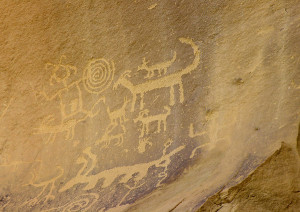
Some of the giant figures have been linked with cliff dwelling, which was common throughout the southwestern United States at that time, and could even go back as far as 2000 years. Now, that’s not exactly pinpointing the age of the Intaglios – somewhere between 1100 and 2000 years old – but it definitely means they pre-date the arrival of Columbus and any other Europeans by a wide margin.
Who?
Most of the indigenous peoples of the southwest have lived there for a very long time, and it’s most likely that their ancestors were the people responsible for creating the intaglios.
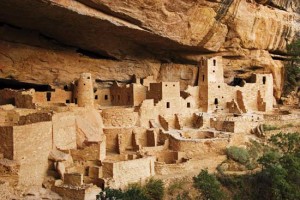
Between 900 AD and 1300 AD, the ancestors of today’s Pueblo tribes built multi-story dwellings, much like modern apartment buildings, into the sides of the many steep cliffs found throughout the southwest and often chipped symbols and images into the desert varnish covering some of the rock faces near their dwellings. Amazingly, the people who solved the complexities of creating the intaglios had not yet invented the wheel, and lived every day in what is now a harsh environment, constantly facing serious challenges in meeting their own basic needs, and only had access to primitive, stone-age tools. That begs the question: why did these people devote so much time and energy to create these huge artworks?
Why?
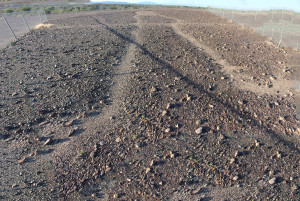
Oral history and traditional beliefs and practices continue to be at the center of Pueblo life today, and it’s highly likely that the same was true for the people who created the giant artworks at Blythe and other areas. According to the nearby Mojave and Quechan tribes, Mastamho, the Creator of Heaven and Earth, decided to create the Colorado River in order to bring water to the desert and the people who lived there.

Hutakulya was one of two mountain lion-persons who assisted Mastamho, and may be the four-legged animal seen near the giant human figure, who is probably Mastamho. In one creation myth, Mastamho plots the death of Sky-Rattlesnake, an evil spirit with dark powers, by cutting off his head before turning himself into a fish-eagle and flying off into oblivion. The spiral glyph beneath the four-legged animal could represent Sky-Rattlesnake. but

spirals also indicate places where “the people,” as most tribes referred to themselves, emerged into this world, often from a world below. Sacred ceremonial dances took place there, honoring Mastamho and some of the rings where people danced were still visible when the intaglios were first “discovered.” They were part of a pilgrimage between the Place of Creation and the Land of Death, and shamans claimed to receive their power from Mastamho through dreams. During the pilgrimages, the shaman would instruct the pilgrims in mythic history and re-enact events from these stories, including the creation of the world, while they beseeched the gods for help. It’s important to remember that the Blythe Intaglios are only a small part of a much larger collection of giant glyphs, and the pilgrimages through the images covered an area from Nevada to the Colorado delta at the Gulf of California in Mexico. The rituals and reenactments not only helped to maintain the power of the shamans, they helped the people to recall their history and understand their place in the world they lived in, much as rituals and reenactments are integral, powerful parts of religions all over the world.
“Simple Explanation” – or Cover-up?
The Colorado River may or may not have been created and directed through the desert by Mastamho, but one little-known fact is for sure: the Colorado actually inundates its flood plain every year, leaving behind fertile soil and silt deposits, much like the Nile River in Egypt.

This provided the people who lived there with a rich farming environment in an otherwise inhospitable arid desert. The Patayan tribe lived in this area between 700 AD and 1550 AD, and some believe the Patayan were responsible for the intaglios. In other areas of the southwest, the Pueblo ancestors created stable irrigation canals to water their crops of corn, beans and squash, but the Patayan had to keep moving their fields in response to the frequent variations in where the river flooded each year.
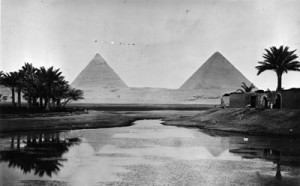
The similarity between the behavior of the Colorado and the Nile Rivers is a simple fact. Far more mysterious is the similarity between the creation myths of the Patayan, Mojave, Quechan and Hopi, and those of the ancient Egyptians, down to minute details in their stories and beliefs. Both rivers are said to be hung between a place of life and creation, and a land of death. Both are said to have been created and their directions set by specific deities; Mastamho in the case of the Colorado, and Hapi in the case of the Nile in Egypt. Both dieties are associated with fertility and north-south direction, and both rivers are related to sacred mountains or mounds, where both creation and divine oversight came from above.
So… are the scientific explanations for the origin and meaning simply all there is to the mystery of the Blythe Intaglios?

Or are they part of a cover-up intended to obscure an ancient, direct relationship between two places at opposite ends of the planet, possibly involving a visitation from Ancient Alien Astronauts whose stories remain forever inscribed into the deserts of the American southwest, and the temples of Egypt? We leave this question for you… and for Erich Von Daniken… to answer for yourselves!


After looking at the picture of Erich Von Daniken, I’ll go with the similar psychology of all human brains. There are, after all, only so many plot lines in all the stories (books and films) we create. Take a group of people with minimal science and hard lives, frequent deaths from each other but mostly natural causeses, and you will get superstition, religion, and probably similar explanations. If they knew about space they could have come up with Von Daniken’s explanation. Baring that, a powerful god, some evil serpent, the gift of water in the desert (duh…), etc etc.
It’s great reading your blog. It is going to be hard to keep it up, but I hope you do.
I agree, the “plot lines” are all very similar no matter where you go, especially among the creation myths. I was surprised how little information was available at the site though… BLM is a sister agency of the National Park Service, and though it’s rare for them to manage “tourist attractions,” they provide a lot more at the few sites they do manage. I had to find most of this information elsewhere, but I thought it would make it more fun to tell the story behind the photos of the geoglyphs. Thanks for reading… and writing!
Can’t help but think of all the times I saw children and adults on the beach, etching drawings in the sand. Some in dimensions rivaling the glyphs above. These beach versions are commonly and similarly cultural icons… men, women, animals, or strange designs with points and curls. They are washed or blown away of course… but with the glyphs, I wonder if we are assigning meaning to the doodles and amusements of our ancestors. Wondering about strange powerful beings from places far away and out of sight probably drove their imaginations as they drive many of us today. We are all wired to do that I think. Of course, all this said, we need to study these sites for their age and contexts. They are like small bones from a large creature. Always fascinating.
Hi Tom,
I agree, these ancient rock artworks are fascinating, and you can find loads of petroglyphs and cave paintings all over the southwest, as well as other places. It’s fun to speculate about their origins and meaning, and I was definitely having some fun with the more ‘crackpot’ explanations in this post. At the same time, we can probably learn something about the people who created these ancient works by talking to their probable descendants, if they’re still around. Among the Pueblo people, a lot of the knowledge and beliefs of the “ancient ones” is still preserved and passed down, even today, by traditional methods… storytelling, dances, rituals and language.
On the west coast, the indigenous people were not so fortunate. For as many as five generations, Junipero Serra and his friars brutally – and successfully – suppressed much of the knowledge, beliefs and culture of tribes like the Chumash, who still live in Ventura, Santa Barbara and the surrounding areas, so the people no longer know what many of their own symbols actually mean. The California Missions served as prisons and torture chambers, even for those who had converted to Catholicism, and the grounds around these places are filled with the unmarked graves of Indians who were murdered by ‘overzealous’ Franciscan friars. The Spanish military governors even tried to stop the carnage, but they were told by the Padres to mind their own business! Oh wait, Junipero Serra, the terrorist leader, is about to become a saint(!?) Okay, never mind!
You may be right about the kiddie doodle idea… what if the intaglios of the four-legged animal and the human figure are really just early attempts at Snoopy and Charlie Brown? Hmmm… maybe I should revise this post!
Thanks for the inspiration!
i loved reading about your adventures. keep them coming. i’ll read them whenever.
esther
Glad you’re enjoying them, Esther… we’ll try not to run out of steam! Another one is coming soon, so stay tuned.
Andy
Really informative & fun to read!
Glad you liked it 🙂
Puedo enviarles mas evidencias en la zona de los Indios KUMIAI en Tecate Mexico Existen Pinturas hechas en ROCAS con una similitud en dibujos
Gracias! Eso suena muy interesante; se puede enviar un enlace a fotos de las pinturas rupestres de Tecate? Si se encuentra en Santa Bárbara de California, que le gustaría el Chumash Painted Cave State Historic Park. Es pequeño, pero interesante, y el Museo de Historia de Santa Bárbara tiene una exposición maravillosa elaborado por ancianos Chumash locales.
youre disrespect for native culture is evident.instead of thinking u know the answeres wich western academics do not.maybe u should not refer to anyone or native people who actually have ancestors and different bellefs as crackpots.how do u know who the gods are man of science and no faith.
Steve,
You seem to have misread what I wrote in this article and in the comments. I used the word “crackpot” to describe the theories of Eric Von Daniken, who could not accept that ancient cultures could have created these intaglios or other monumental works because he thought the people were too primitive. He was wrong; the accomplishments of native cultures are astounding and can be seen all over this country; indeed, all over North and South America.
My wife and I have tremendous respect for native cultures, and have spent years traveling across the U.S. and Canada, learning about the traditions, beliefs and wisdom of both past and present from native people themselves. Native cultures are rich and vibrant, and the experience of learning about them is eye-opening.
You seem to think that science and faith are opposed to one another, but that’s not true. Some of the greatest scientists and mathematicians of all time were indigenous people, and spiritual leaders in the Americas. Ancient native people developed foods such as maize from inedible weeds – the world’s first feat of bioengineering. They cultivated potatoes and yams, major food sources all over the world, and planted squash, beans and corn together, which avoids depleting the soil – something “modern” western farming techniques have yet to match. Their astronomers built observatories that helped not only their agriculture and understanding of the universe, it allowed them to create the most accurate calendar ever seen until the 20th century, and they did this in multiple cultures over 1000 years ago. Over 60 percent of the food consumed on earth today comes from the achievements of ancient bioengineers of native cultures in the Americas. Europeans arriving in the Americas would not have survived here without the help of native people. The U.S. constitution and our form of government would not exist but for the Haudenosaunee federation known as the Six Nations.
Respect for nature, for other species, and an understanding of our true place in the world is to be custodians of nature, not its destroyers or its masters – all these come from the beliefs and traditions of native cultures. “Western academics” are only beginning to understand the past here by working closely with, and respecting the views and wealth of knowledge of natives whose ancestors have passed down their oral histories.
I hope that clarifies my views about native cultures.
Andy